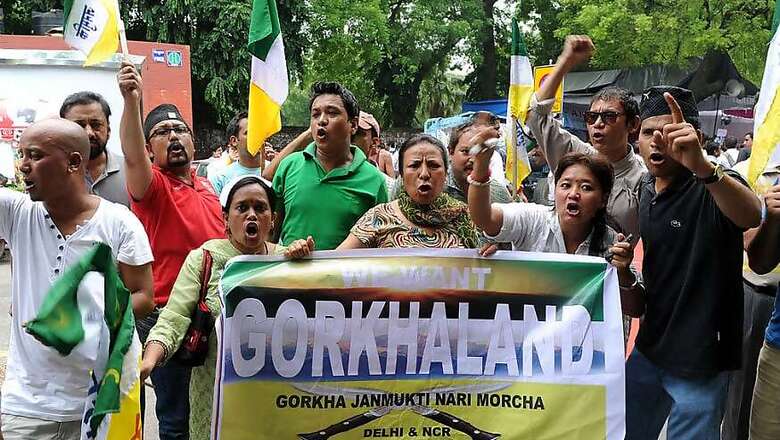
views
The genesis of Gorkhaland movement is seen in the Hillmens' Association demand for a separate administrative unit for Darjeeling district in 1907. Since then the demand for a separate administrative set up for Darjeeling has been raised by many in different intervals of time. Various memorandums to the British were submitted in 1909, 1917, 1930, 1934, 1942 and 1947. However, after the independence of India the demand has been for a creation of separate state of Gorkhaland within the Union of India.
The declaration of the Indian National Congress, that the reorganisation of the provinces would take place on the basis of language, in its Nagpur session in 1920 gave a renewed impetus to the demand of the Gorkha people. This led the people to vociferously demand the inclusion of Nepali language in the schools’ curriculum. This was seen as many to be a domination of the Nepali speaking Gorkha people over the other two communitites, the Lepchas and Bhutias who were also instrumental in demanding the separate administrative unit for Darjeeling from the very beginning. The need to resolve the problem before it became detrimental to the unity of the people was understood by the leaders. Thus a meeting of the three communities was held and a decision to bring out a monthly magazine called 'Nebula' using the initials of these communities was taken. More importantly, it was decided that ethnically the three communities would be called Gorkha and their language would be Nepali (Samanta 2000:83). This understanding of Gorkha have been expanded today to include also those communities like the Marwaris, Biharis and Bengalis who are residents of the proposed state of Gorkhaland and support the creation of Gorkhaland.
The 1980s witnesses the Gorkhaland agitation under the leadership of Gorkha National Liberation Front (GNLF). This phase of the movement was violent and 1200 hundred lives (official figures) were lost and property worth crores of rupees was destroyed. The movement culminated in 1988 when the GNLF signed the tripartite agreement on Darjeeling Gorkha Hill Council (DGHC). With the signing of this accord the GNLF dropped the demand for Gorkhaland. GNLF led by Subhash Ghising was thrown out of power in 2007 by Gorkha Janmukti Morcha (GJM) led by Bimal Gurung. Under the leadership of Bimal Gurung, from the very beginning it was declared that the Gorkhaland movement would be peaceful one and fought on Gandhian principles of peace and non-violence. However, the state machinery retaliated brutally and many lives were lost till a tripartite agreement for the creation of Gorkhaland Terrritorial Administration (GTA) was signed. Unlike the DGHC agreement, the latter mentions that the demand for Gorkhaland will not be dropped.
In the month of June 2017 the compulsory introduction of Bengali language in the schools of West Bengal and thereby in Darjeeling too led to a new phase of movement which witnessed the killing of 11 people, youths on hunger strike unto death (which was subsequently lifted on the request of Home Minster) and a general strike which has entered the 80th day with people still resolute that the strike will only be lifted once concrete talks on the Gorkhaland movement begins. The unilateral call to lift the strike, by some leaders of GJM led to spontaneous protests across Darjeeling whereby the people voiced their displeasure. The people have clearly expressed that they are willing to undergo any hardship but the strike will be lifted only when a meaningful dialogue on the creation of Gorkhaland takes place.
This new found confidence among the people is the result of the involvement of the Gorkha diaspora from across the globe and this has perplexed many. This is the result of the shared experience and history of the people. Most of the people have experienced the 80s agitation in their younger days and are aware of the importance of Gorkhaland for their existence, identity and development. This has a pertinent connection with the issue of governance in Darjeeling. The region, the proposed state of Gorkhaland, has witnessed total failure on the part of the West Bengal government. Since 2004 the panchayats are non-existent. The root of democracy has been missing in the hills. Instead of the panchayats, the government started forming 'Development Boards' which was a ploy to divide the people on the lines of their caste. Political patronage was extended to all those who were in favour of the ruling party in West Bengal (TMC) and therefore all forms of corruption were conveniently overlooked. The avenues for people to improve their livelihood shrunk. This led to massive out migration and this has led to the support from the Gorkha diaspora.
With the movement intensifying with each passing day and support from every increasing section of the people, both Gorkha and non-Gorkha coming, some have started questioning the economic viability of Gorkhaland, if created. The proposed state is not just economically but also culturally and politically viable. The revenue from the tea, timber and tourism itself is enough for the proper functioning of the state. However, there are other sectors which will add to the economy like hydroelectric power, non-forest timber product, flora and fauna, small scale industry and the start-ups and business entrepreneurship that people have shown. Another, often overlooked point is the most important additions to the economy of the place, i.e. the remittance economy. With the Gorkhas spread across the globe this contribution to the economy is very high. This importance of the diaspora is visible when we look at the role they are playing in providing food relief to the people of Darjeeling especially by reaching out to those families and villages where people have not been able to earn their daily wages and therefore make ends meet.
It is also politically viable because it will be a small state with lot of potential to generate its own resources and as is evident from the failure of bigger states and success of smaller states in present day India. The proposed state will be and already is a cultural melting pot with people belonging to different regions of India as well as ethnicity, caste and creed living there. It will therefore encapsulate the vision of vibrant and inclusive India with the potential to excel in very arena.
(Binu Sundas was an Assistant Professor in the Department of Social Systems and Anthropology, Sikkim University and currently teaches at Miranda House, Delhi University)
















Comments
0 comment